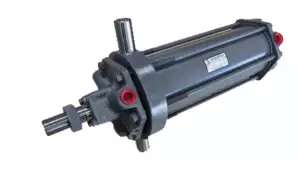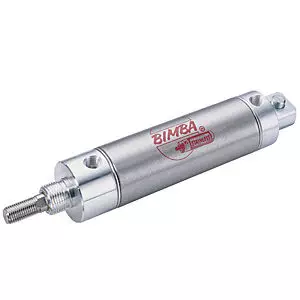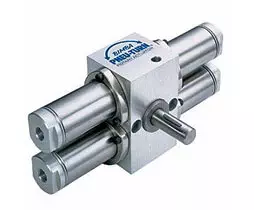SKEANS offers numerous air, hydraulic, and rodless cylinders & Actuators from industry leading suppliers.
Pneumatic Cylinders & Actuators provide high force and speed at low unit cost in a small footprint. As a matter of fact, pneumatic cylinders provide more force and speed per unit size than any other actuator technology except hydraulic. Force and speed on pneumatic actuators are easily adjustable and are independent of each other.
The SKEANS/NOPAK SG Series air cylinders were jointly developed back in the 1970s, having been designed with input from customers throughout Western Canada who are working in the rugged resource industry. It incorporates double rod bearings, a bolt-on gland ring, and a clevis jam nut, along with optional piston rod, clevis pin, and trunnion horn sizes to make it easy to optimize the cylinder for your application. If you need higher speeds and consistent operation, many of our clients trust the heavy-duty SG Series to get the job done, complete with low friction seals and pre-lubricated wear rings.
See our options list to choose the design best suited to help you maximize your production. If you need a custom design, our SKEANS service department is always on-hand to assist you in designing or modifying a cylinder for the solution you need.
Pneumatic cylinders are commonly used in a range of industrial and commercial applications, including manufacturing, automation, and transportation industries. They are compatible with various operating environments and are available in different sizes, shapes, and configurations to suit specific needs. Pneumatic cylinders have many advantages, including reliability, affordability, ease of maintenance, and high power-to-weight ratio. They can perform various tasks, including pushing, pulling, lifting, and holding objects.
SKEANS Pneumatic brands are: Bimba, Camozzi, Flairline, Nopak, PHD & TRD
Hydraulic cylinders are devices that use fluid pressure to exert force on a piston, which moves in a linear motion to perform work. Hydraulic cylinders are commonly used in machinery, construction equipment, and presses. The force and speed of the cylinder’s movement can be controlled by adjusting the pressure and flow of the fluid. Hydraulic cylinders have several advantages over other types of actuators, including high force density, precise control, and the ability to operate in extreme conditions. They are also durable and require minimal maintenance.
A rodless cylinder is a type of pneumatic or hydraulic cylinder that does not have a piston rod extending outside the cylinder. Instead, the piston is connected to an internal band or magnet that moves along the cylinder’s interior wall. This design results in a longer stroke length compared to traditional cylinders, making rodless cylinders ideal for applications where space is limited.
Rodless cylinders are often used in applications that require precise and smooth linear motion, such as automated manufacturing and assembly line equipment, robotics, and packaging machinery. They also eliminate the need for external guides or supports that traditional cylinders require, reducing maintenance requirements and lowering overall costs. Overall, rodless cylinders are a versatile and efficient solution for many industrial automation applications.
Rotary actuators work by converting hydraulic, pneumatic, or electric power into torque, which can be used to rotate a shaft or gear. The rotating shaft can then be attached to other components such as arms, grippers, or clamps, allowing them to move in a circular motion.
They are available in various designs, including pneumatic or hydraulic, rack and pinion, and electric . Each design has its unique features and advantages, making it suitable for its specific applications.
A pneumatic gripper is a device that uses compressed air to hold and move objects. It is a common tool used in manufacturing, robotics and automation. The gripper works by using air pressure to activate a piston which closes and opens the jaws of the gripper, allowing it to grasp or release an object. Pneumatic grippers are preferred in industrial settings due to their speed, precision, and reliability. They can be configured in different ways to suit different applications, such as parallel and angular grippers, and can handle various types of materials. Pneumatic grippers are also easy to control and integrate into automated systems, making them efficient tools for increasing productivity and reducing labor costs.
A pneumatic clamp is a type of mechanical device that uses compressed air to clamp, hold and secure objects or materials. It is commonly used in industrial and manufacturing settings to hold pieces of work in place while they are being processed or worked on. Pneumatic clamps work by using air pressure to drive a piston that moves a clamping device up and down in order to grip the object or material. They are known for their speed, power and accuracy, and are widely used in a variety of applications such as welding, machining, woodworking, and assembly operations. Pneumatic clamps are preferred over hydraulic or electric clamps in many cases due to their quicker response time, uniformity of clamping force and lower costs of operation.
A guided actuator is a device that converts input energy into force while being precisely guided along a certain path. This path can be straight, circular, or even more complex depending on the application. Guided actuators are often used in industries such as robotics, aerospace, and manufacturing, where accuracy and precision are critical.
Guided actuators consist of two main components: the actuator and the guide or way. The actuator generates the motion while the guide directs the motion along the desired path. There are different types of guides or ways, including linear bearings, shafts, rails, and slides. The chosen guide depends on the application requirements, load capacity, and environmental conditions.
Some benefits of guided actuators include increased accuracy, repeatability, and durability. They also provide smooth and precise motion, resulting in improved efficiency and productivity.
































